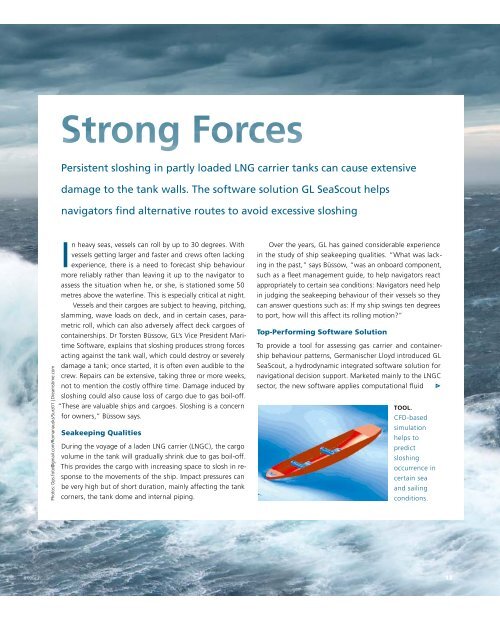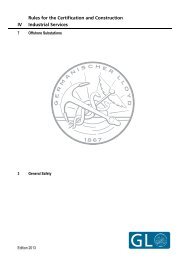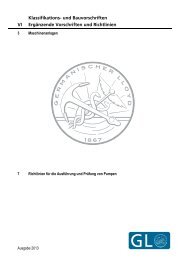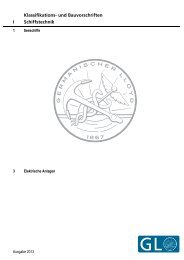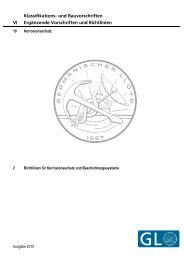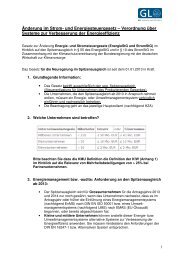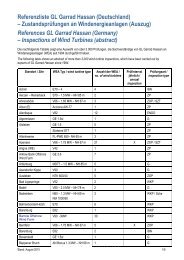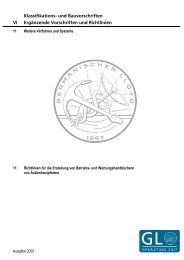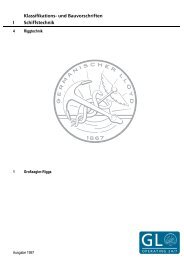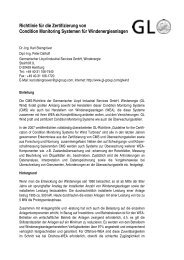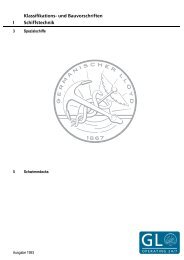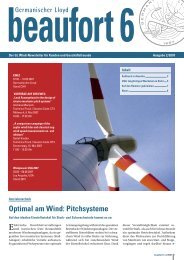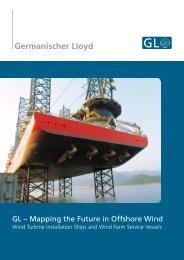Ways to Conserve Energy on Board - DNV
Ways to Conserve Energy on Board - DNV
Ways to Conserve Energy on Board - DNV
You also want an ePaper? Increase the reach of your titles
YUMPU automatically turns print PDFs into web optimized ePapers that Google loves.
Persistent sloshing in partly loaded LNG carrier tanks can cause extensive<br />
damage <str<strong>on</strong>g>to</str<strong>on</strong>g> the tank walls. The software soluti<strong>on</strong> GL SeaScout helps<br />
naviga<str<strong>on</strong>g>to</str<strong>on</strong>g>rs find alternative routes <str<strong>on</strong>g>to</str<strong>on</strong>g> avoid excessive sloshing<br />
Pho<str<strong>on</strong>g>to</str<strong>on</strong>g>s: Dps.fo<str<strong>on</strong>g>to</str<strong>on</strong>g>@gmail.com/Romanausks/Surz01 | Dreamstime.com<br />
In heavy seas, vessels can roll by up <str<strong>on</strong>g>to</str<strong>on</strong>g> 30 degrees. With<br />
vessels getting larger and faster and crews often lacking<br />
experience, there is a need <str<strong>on</strong>g>to</str<strong>on</strong>g> forecast ship behaviour<br />
more reliably rather than leaving it up <str<strong>on</strong>g>to</str<strong>on</strong>g> the naviga<str<strong>on</strong>g>to</str<strong>on</strong>g>r <str<strong>on</strong>g>to</str<strong>on</strong>g><br />
assess the situati<strong>on</strong> when he, or she, is stati<strong>on</strong>ed some 50<br />
metres above the waterline. This is especially critical at night.<br />
Vessels and their cargoes are subject <str<strong>on</strong>g>to</str<strong>on</strong>g> heaving, pitching,<br />
slamming, wave loads <strong>on</strong> deck, and in certain cases, parametric<br />
roll, which can also adversely affect deck cargoes of<br />
c<strong>on</strong>tainerships. Dr Torsten Büssow, GL’s Vice President Maritime<br />
Software, explains that sloshing produces str<strong>on</strong>g forces<br />
acting against the tank wall, which could destroy or severely<br />
damage a tank; <strong>on</strong>ce started, it is often even audible <str<strong>on</strong>g>to</str<strong>on</strong>g> the<br />
crew. Repairs can be extensive, taking three or more weeks,<br />
not <str<strong>on</strong>g>to</str<strong>on</strong>g> menti<strong>on</strong> the costly offhire time. Damage induced by<br />
sloshing could also cause loss of cargo due <str<strong>on</strong>g>to</str<strong>on</strong>g> gas boil-off.<br />
“These are valuable ships and cargoes. Sloshing is a c<strong>on</strong>cern<br />
for owners,” Büssow says.<br />
Seakeeping Qualities<br />
During the voyage of a laden LNG carrier (LNGC), the cargo<br />
volume in the tank will gradually shrink due <str<strong>on</strong>g>to</str<strong>on</strong>g> gas boil-off.<br />
This provides the cargo with increasing space <str<strong>on</strong>g>to</str<strong>on</strong>g> slosh in resp<strong>on</strong>se<br />
<str<strong>on</strong>g>to</str<strong>on</strong>g> the movements of the ship. Impact pressures can<br />
be very high but of short durati<strong>on</strong>, mainly affecting the tank<br />
corners, the tank dome and internal piping.<br />
Over the years, GL has gained c<strong>on</strong>siderable experience<br />
in the study of ship seakeeping qualities. “What was lacking<br />
in the past,” says Büssow, “was an <strong>on</strong>board comp<strong>on</strong>ent,<br />
such as a fleet management guide, <str<strong>on</strong>g>to</str<strong>on</strong>g> help naviga<str<strong>on</strong>g>to</str<strong>on</strong>g>rs react<br />
appropriately <str<strong>on</strong>g>to</str<strong>on</strong>g> certain sea c<strong>on</strong>diti<strong>on</strong>s: Naviga<str<strong>on</strong>g>to</str<strong>on</strong>g>rs need help<br />
in judging the seakeeping behaviour of their vessels so they<br />
can answer questi<strong>on</strong>s such as: If my ship swings ten degrees<br />
<str<strong>on</strong>g>to</str<strong>on</strong>g> port, how will this affect its rolling moti<strong>on</strong>?”<br />
Top-Performing Software Soluti<strong>on</strong><br />
To provide a <str<strong>on</strong>g>to</str<strong>on</strong>g>ol for assessing gas carrier and c<strong>on</strong>tainership<br />
behaviour patterns, Germanischer Lloyd introduced GL<br />
SeaScout, a hydrodynamic integrated software soluti<strong>on</strong> for<br />
navigati<strong>on</strong>al decisi<strong>on</strong> support. Marketed mainly <str<strong>on</strong>g>to</str<strong>on</strong>g> the LNGC<br />
sec<str<strong>on</strong>g>to</str<strong>on</strong>g>r, the new software applies computati<strong>on</strong>al fluid<br />
Tool.<br />
CFD-based<br />
simulati<strong>on</strong><br />
helps <str<strong>on</strong>g>to</str<strong>on</strong>g><br />
predict<br />
sloshing<br />
occurrence in<br />
certain sea<br />
and sailing<br />
c<strong>on</strong>diti<strong>on</strong>s.<br />
01/2013 13


